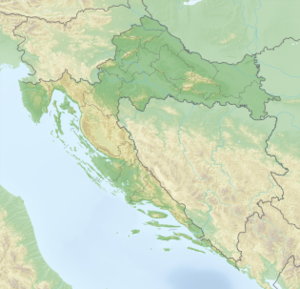Sisak fortress
| Sisak fortress | ||
|---|---|---|
|
Sisak Fortress today |
||
| Creation time : | 16th Century | |
| Castle type : | Flatland fortress | |
| Conservation status: | received most of the essential parts |
|
| Standing position : | Nobles | |
| Construction: | Ashlar , brick | |
| Place: | Sisak , Croatia | |
| Geographical location | 45 ° 29 '16 " N , 16 ° 22' 26" E | |
|
|
||
The fortress Sisak [ Sissak ] ( Croatian Tvrđava Sisak or Stari grad Sisak ) is a lowland fortress located in the central Croatian town of Sisak . It is located at the confluence of the Kupa and the Save and is therefore partially protected by water in a natural way. The in ground plan triangular fort was built in the 16th century and to this day well preserved. At each corner there are large round towers with a pointed roof, which are connected by straight walls more than 30 meters long . The fortress became famous after the brilliant victory of the Habsburg army over the overwhelming Turkish army in the Battle of Sisak on June 22, 1593. Today the fortress houses the Sisak City Museum .
historical overview
The fortress was built between 1544 and 1550 to protect Croatian territories because of the threatened Turkish conquests. The construction work was ordered by the bishop of Zagreb or zagreber Kaptol , as this area belonged to the Catholic Church . The master masons were instructed by Petar (Pietro) de Mediolanus from Milan ( director muratorum ). The total cost of building the fortress was more than 3,300 florins (forints) .
When Hassan Pasha Predojević became ruler of the Paschaluk of Bosnia in 1591 , he made several attacks on the fortress. During his last attack, which took place on June 22, 1593, Predojević lost his life and his army the battle. However, the fortress was damaged and had to be repaired.
After the loosening of Ottoman pressure in the 17th century, the fortress changed hands several times. From time to time it was rebuilt, but its main structure was preserved. During the Second World War it was damaged by shell hits, with the west tower in particular being partially destroyed.
In 1951 the Sisak City Museum was founded and moved to the fortress. It houses, among other things, collections on archeology , ethnology , cultural history and coinage .
photos
See also
- List of castles and chateaus in Croatia
- Turkish Wars
- Croatia in the Habsburg Monarchy
- List of museums in Croatia




